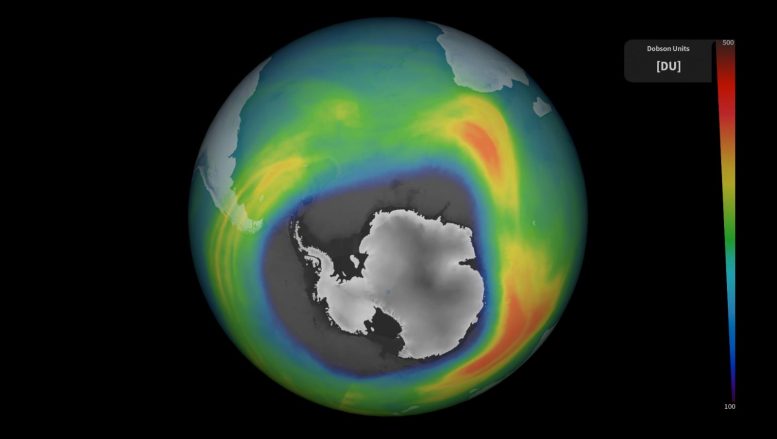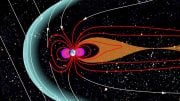
Measurements from the Copernicus Sentinel-5P satellite show this year’s ozone hole over the Antarctic. Credit: Contains modified Copernicus Sentinel data (2023)/processed by DLR
The Copernicus Sentinel-5P satellite has detected one of the largest ozone holes over Antarctica, possibly influenced by the 2022 Hunga Tonga-Hunga Ha’apai eruption. Despite historic damages, initiatives like the Montreal Protocol aim for global ozone layer recovery by 2050.
Measurements from the Copernicus Sentinel-5P satellite show that this year’s ozone hole over Antarctica is one of the biggest on record. The hole, which is what scientists call an ‘ozone depleting area,’ reached a size of 26 million sq km (10 million sq miles) on September 16, 2023. This is roughly three times the size of Brazil.
Ozone Hole Measurements
The size of the ozone hole fluctuates on a regular basis. From August to October, the ozone hole increases in size – reaching a maximum between mid-September and mid-October. When temperatures high up in the stratosphere start to rise in the southern hemisphere, the ozone depletion slows, the polar vortex weakens and finally breaks down, and by the end of December, ozone levels return to normal.
Launched in October 2017, Copernicus Sentinel-5P – short for Sentinel-5 Precursor – is the first Copernicus satellite dedicated to monitoring our atmosphere. It is part of the fleet of Copernicus Sentinel missions that ESA develops for the European Union’s environmental monitoring program.
The satellite carries an advanced multispectral imaging spectrometer called Tropomi. It detects the unique fingerprints of atmospheric gases in different parts of the electromagnetic spectrum to image a wide range of pollutants more accurately and at a higher spatial resolution than ever before.
The Tropomi total ozone measurements are processed within the Sentinel-5P ground segment at the German Aerospace Center (DLR) using algorithms that has been developed by DLR and the Royal Belgium Institute for Space Aeronomy (BIRA-IASB).
This animation uses Sentinel-5P total ozone measurements and shows the evolution of the ozone hole over the South Pole from September 1 to September 29, 2023. The Tropomi total ozone measurements are processed within the Sentinel-5P ground segment at the German Aerospace Center (DLR) using algorithms that have been developed by DLR and the Royal Belgium Institute for Space Aeronomy (BIRA-IASB). Credit: Contains modified Copernicus Sentinel data (2023)/processed DLR
Diego Loyola, DLR senior scientist, commented, “The Sentinel-5P total ozone products have an accuracy at the percentage level compared with ground-based data and this allows us to closely monitor the ozone layer and its evolution. The Tropomi measurements are extending the global ozone data record of European satellite sensors covering almost three decades.”
The Sentinel-5P total ozone column product is provided within three hours after measurement time to the Copernicus Atmosphere Monitoring Service (CAMS). CAMS, which is implemented by the European Centre for Medium-Range Weather Forecasts (ECMWF) on behalf of the European Union, includes these near-real-time Sentinel-5P ozone data in their data analysis and forecast system.
CAMS senior scientist Antje Inness, said, “Our operational ozone monitoring and forecasting service shows that the 2023 ozone hole got off to an early start and has grown rapidly since mid-August. It reached a size of over 26 million sq km on 16 September making it one of the biggest ozone holes on record. Tropomi ozone data are an important dataset for our ozone analysis.”
Factors Impacting the Ozone Hole’s Size
The variability of the size of the ozone hole is largely determined by the strength of a strong wind band that flows around the Antarctic area. This strong wind band is a direct consequence of Earth’s rotation and the strong temperature differences between polar and moderate latitudes.
If the band of wind is strong, it acts like a barrier: air masses between polar and temperate latitudes can no longer be exchanged. The air masses then remain isolated over the polar latitudes and cool down during the winter.
Although it may be too early to discuss the reasons behind the current ozone concentrations, some researchers speculate that this year’s unusual ozone patterns could be associated with the eruption of the Hunga Tonga-Hunga Ha’apai in January 2022.
The status of the ongoing ozone hole is displayed here as a 3D-rendered animation. It shows the evolution of the ozone hole over the South Pole from July 1 to September 24, 2023. Credit: Contains modified Copernicus Sentinel data (2023)/processed by CAMS/ECMWF
Antje explains, “The eruption of the Hunga Tonga volcano in January 2022 injected a lot of water vapor into the stratosphere which only reached the south polar regions after the end of the 2022 ozone hole.
“The water vapor could have led to the heightened formation of polar stratospheric clouds, where chlorofluorocarbons (CFCs) can react and accelerate ozone depletion. The presence of water vapor may also contribute to the cooling of the Antarctic stratosphere, further enhancing the formation of these polar stratospheric clouds and resulting in a more robust polar vortex.”
However, it’s important to note that the exact impact of the Hunga Tonga eruption on the Southern Hemisphere ozone hole is still a subject of ongoing research. This is due to the absence of previous instances where such substantial amounts of water vapor were injected into the stratosphere in modern observations.
ESA’s mission manager for Copernicus Sentinel-5P, Claus Zehner, adds, “The Sentinel-5P total ozone columns provide an accurate means to monitor ozone hole occurrences from space. Ozone hole phenomena cannot be used in a straightforward manner for monitoring global ozone changes as they are determined by the strength of regional wind fields that flow around polar areas.”
In the 1980s, scientists discovered a gaping hole in Earth’s ozone layer, caused by humanmade chemicals. But thanks to the historical Montreal Protocol, the world came together to take bold action to save our planet. Decades later, we can see the steady recovery of the ozone hole. How did we do it? And what does space have to do with it? Join us as we explore the journey of the ozone hole, from its alarming discovery to the incredible strides made to fix it, and how satellites are helping us track its recovery. Credit: ESA – European Space Agency
Effects and Remedies of Ozone Depletion
In the 1970s and 1980s, the widespread use of damaging chlorofluorocarbons in products such as refrigerators and aerosol tins damaged ozone high up in our atmosphere – which led to a hole in the ozone layer above Antarctica.
In response to this, the Montreal Protocol was created in 1987 to protect the ozone layer by phasing out the production and consumption of these harmful substances, which is leading to a recovery of the ozone layer.
Claus concludes, “Based on the Montreal Protocol and the decrease of anthropogenic ozone-depleting substances, scientists currently predict that the global ozone layer will reach its normal state again by around 2050.”
ESA has been involved in monitoring ozone for many years. Launched in October 2017, Copernicus Sentinel-5P satellite is the first Copernicus satellite dedicated to monitoring our atmosphere. With its state-of-the-art instrument, Tropomi, it is able to detect atmospheric gases to image air pollutants more accurately and at a higher spatial resolution than ever before from space.









“…, initiatives like the Montreal Protocol aim for global ozone layer recovery by 2050.”
That sounds less certain than the usual pronouncement that “Based on the Montreal Protocol and the decrease of anthropogenic ozone-depleting substances, scientists currently predict that the global ozone layer will reach its normal state again by around 2050.”
If an historical graph of the size of the ‘Ozone Hole’ were provided for readers, [Such as ca be found here: https://ozonewatch.gsfc.nasa.gov/ ] I think that they would similarly come to the conclusion that, based on the last few years, the 2050 date seems optimistic.
Let me get this straight: Ozone hole only forms in southern hemisphere winter, when Antarctica gets NO sunlight. All of the populated landmasses (Australia, New Zealand, Chile, S Africa) around it have a larger than normal concentration of ozone, blocking dreaded infrared sunlight. What’s the big deal? Just like ‘climate change’, it is most effected by nature (the sun, volcanoes). Mankind can not influence either the ozone or climate to the extent the elite want us to believe.
Ozone effectively blocks ultra-violet (UV) radiation from reaching the troposphere and surface, not infrared. Ozone is metastable, basically meaning that it decomposes back into regular oxygen, with a fairly short half-life. Most ozone is generated in the Tropics, and moves pole-wards through the Brewer-Dobson (B-D) circulation, effectively replacing the decayed ozone. However, once the Winter Austral Circumpolar Vortex gets established, the B-D circulation cannot replace the decayed ozone. Thus, the net ozone concentration declines within the vortex, and increases outside it. In the Austral Spring, with returning sunlight, photocatalytic reactions driven by sunlight increases the rate of ozone destruction when it encounters halogen compounds, such as dissociated CFCs, adsorbed onto stratospheric ice crystals. [I don’t think anyone should have serious complaints about my description of the process, other then encountering some unfamiliar words.]
However, it is my opinion that the role of halogens is overstated, and thus the expectations of the Montreal Protocol are unrealistic. It seems to me that the role of the Austral Circumpolar Vortex, and the regional air temperatures, are understated. Typically, people don’t recognize that the sun NEVER gets directly over the ‘Ozone Hole,’ therefore, the sunlight enters at a low angle through a long path length that includes elevated ozone levels that causes greater scattering and absorption than in the Tropics, and there are few living things that are at risk even if there is increased surface UV. So, the risks are also overstated.
People have gotten Nobel prizes extolling the dangers of stratospheric ozone depletion, and some of the younger researchers have careers based the paradigm of humans being responsible for ozone destruction. So, there are social barriers to an objective analysis of the issue. Mankind CAN influence both the stratospheric ozone and climate, but I think that the role of humans is significantly overstated.
Thank you Clyde for clarity. How do we break thru the social barriers and regain sanity?
I wish I knew the answer to your question. It is my impression that younger people are more inclined to buy into the poorly supported claims of climatology because they seem to think that science is about consensus. Secondly, I think that scientists being trained the last two or three decades have become advocates for their beliefs and have not learned that the consummate scientist is supposed to be a dispassionate observer; that is, not biased. If that is the case, then I think that our educational system has failed us and that needs to be addressed.
However, there is little motivation for change when people think that they are right to believe what they do. Therefore, change will probably be painful. People will have to learn the hard way that society is being led down a Garden Path by having things fall apart. We are in a unique point in the evolution of our technological society. Most of the easily (cheaply) obtainable mineral resources are exhausted and what remains requires ever larger quantities of energy (Money!) to be extracted and refined. If the world were to experience another Great Depression, only governments might have the money (albeit at the cost of hyperinflation) to mine low-grade ores to even maintain some semblance of the standard of living we know now. Know nothing bureaucrats will be making decisions about what things consumers will be able to buy, like only EVs. Furthermore, if societies are dependent on dysfunctional governments to supply critical resources, one can expect to lose not only the current standard of living, but many freedoms as well.
Scientists can hardly come up with an idea and a theory and make money for them. Science has reached the point of explosion at this time and the value of the knowledge of today’s scientists has become worthless. I know secrets about the earth that few scientists know, but no one knows the discovery that I made. I don’t care, I know there are secrets of humans two thousand meters below the bed of all big cities, in the museums of big cities underground, but no one values the discovery I made and they don’t believe my words